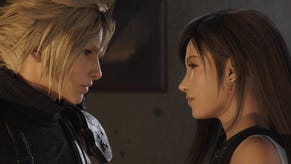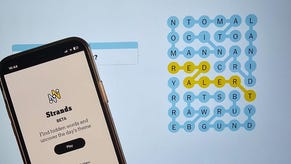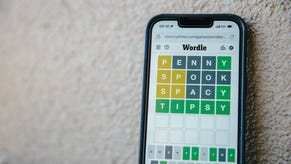Queen's Blood matches, rules and card types in Final Fantasy 7 Rebirth
How to play Queen's Blood.
Queen's Blood is the card mini-game you may find yourself spending hours playing in Final Fantasy 7 Rebirth. Like similar card games in other RPGs, like Gwent in The Witcher 3 and Blade from Legend of Heroes: Cold Steel, Queen's Blood has its own unique in-universe rules filled with creativity.
Queen's Blood is a 1v1 mini-game played on a 3x5 grid board and, as you journey through Final Fantasy 7 Rebirth, you'll be able to expand and build your deck by purchasing new cards.
Here, we'll lay down the rules on how to play Queen's Blood, including looking at the card types, and all the intricacies that come with this surprisingly well thought out game.
On this page:
How to unlock Queen's Blood in Final Fantasy 7 Rebirth
You'll be introduced to Queen's Blood during the second chapter of Final Fantasy 7 Rebirth - A New Journey Begins. It's the very first cutscene of the chapter and getting your first deck is unmissable. The game will ask whether you want to view the tutorial, but you can skip it if you'd like.

Queen's Blood basic rules in Final Fantasy 7 Rebirth explained
In Queen's Blood, each player takes turns placing one card on the board from their hand onto one of the three horizontal lanes. The board starts out with having three pawns placed on the first tiles on each row for you and your opponent (green for you, red for your opponent). These are the initial tiles you can place monsters on.
A Queen's Blood match ends when both you and your opponent pass turns in succession of each other. In order to win, you must have a higher total score than your opponent. Scores are tallied by adding up the value of each card in that particular lane, as shown with the numbers at the end of the board. The catch is that only the higher number in that lane will count towards the point total. For example, if your opponent scores a 3 in the top lane and you score a 4, your score will override the opponents, and you will start with a total of 4 points while your opponent has 0, and vice versa.
You'll eventually unlock new mechanics as you progress through the game. You can mulligan your cards at the start of a match, swapping out as many as you want from your starting hand for new ones. If you have a bunch of high ranking cards you can't play right away, this is definitely something you want to take advantage of.
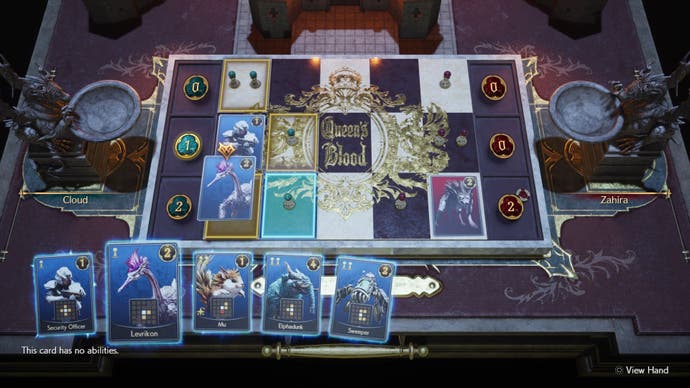
Queen's Blood card types in Final Fantasy 7 Rebirth explained
Each Queen's Blood card contains two numbers at the top. On the left corner, you have the Rank, and the Power on the right corner. The Rank is represented by the number of pawns, so if a card has two pawns, then its Rank is 2. When you start a match, you only have tiles on the board for one pawn, meaning you cannot summon a Rank 2 monster yet.
The Power Value on the right corner indicates how many points you'll gain on the row if successfully summoned. So if your card has the number 3 on the right hand corner, then you'll earn 3 points in that row.
Cards can also have special abilities. If it does, then there will be a star icon at the bottom left. These special abilities have a wide range of effects. Some have enhancement abilities, which increase the Power Value of allied cards in surrounding circles, and some can add new monsters to your hand when summoned.
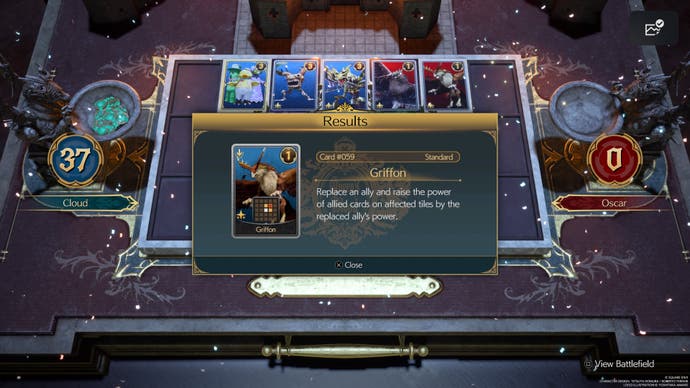
There are also enfeeblement abilities, where some cards can decrease the power value of others when summoned to the board. When a card's value hits 0, then it's destroyed and the tile on the board becomes neutral.
And lastly there are replacement abilities. This is where an existing card on the board must be destroyed in order for the new monster to be summoned. Some of the unique aspects of replacement cards is that they don't require a tile on the board with a specific rank to play, and they can activate cards whose abilities only trigger when destroyed.
Queen's Blood Matches in Final Fantasy 7 Rebirth explained
Ok, so how do you actually play Queen's Blood? The main objective is to expand your influence and cover as much of the board as you possibly can, restricting your opponent's movement. Each card takes up a certain amount of space, which you can see in the card's picture. The white tile in the picture is where the card is summoned, while the surrounding yellow tiles establish where your next pawns will be.
Overlapping yellow tiles will increase the rank of your pawns, letting you summon higher power value monsters and giving you a better chance to dominate that row. Another thing worth mentioning is that if your tiles overlap your opponent's, you can claim their position on the board as yours and summon a monster of your own on the next turn. The same goes with your opponent as well.
For example, placing down a Capparwire monster in the middle lane at the start of the match will immediately increase the ranks of the top and bottom pawns, and let you summon a monster on the tile next to it.
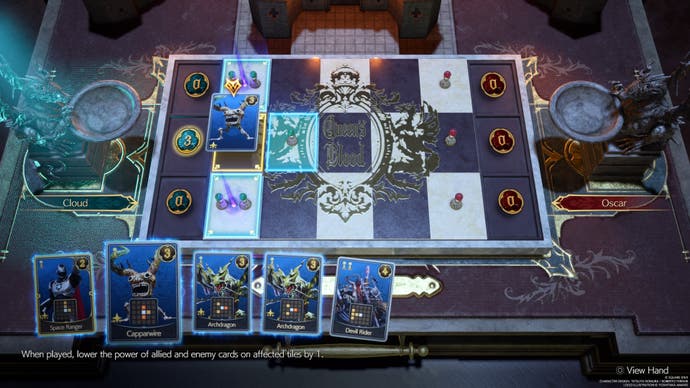
Once neither of you can play anymore cards, the match ends and the scores tally up. In many cases, winning against your opponent earns you new cards. You can also buy cards at the major cities you visit throughout the game.
You can see who you can challenge to a game of Queen's Blood by seeing who has the golden number icon above their heads. The higher the number, the tougher the opponent is. You have a rank as well, and the higher your rank, the more opponents you can challenge.
And that's how you play Queen's Blood!




.png?width=291&height=164&fit=crop&quality=80&format=jpg&auto=webp)




